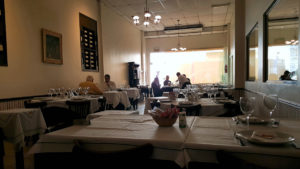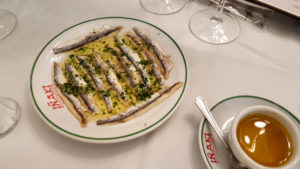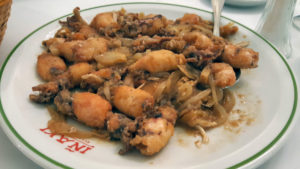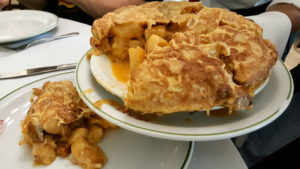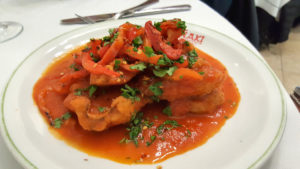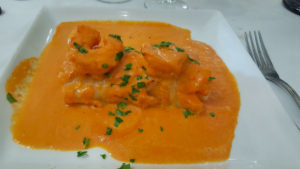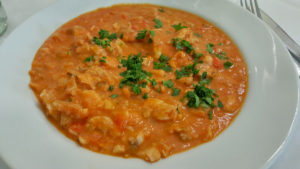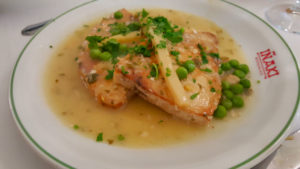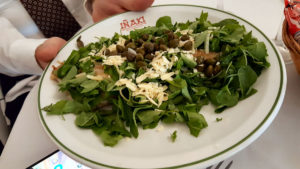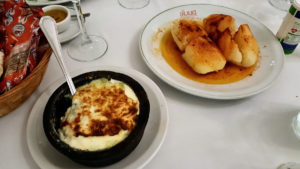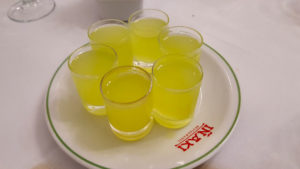It was slightly over a dozen years ago that I first set foot in Iñaki, Moreno 1341, Monserrat. I think I set foot in there a second time maybe a year later, when a friend was visiting town. And, enjoyed it both times, though for the period, found it to be a bit pricey, and despite having kept it on my list of favorite Spanish restaurants in town, hadn’t been back. But these days, everything seems pricey here, and in truth, it had only been expensive in contrast to the sorts of places I was generally eating – it was the heyday for cheap eats here in BA, with the economy still massively depressed.
Now, Iñaki is the “fifth generation” restaurant in the history of its founder, one Fermín Uriona, who arrived as a youngster from the Basque area of Spain back in 1947. In succession, he founded José Txiki in 1967, then Laurak Bat in the Spanish Basque Cultural Center in the 80s, both now closed. Then he became the president of the French Basque Association, and founded the restaurant in its cultural center, which is just across the street from Iñaki (and on my list to try), and then Vasco Fermín, a short lived spot (mostly due to the economic crash in the early 2000s), followed during the recovery period, just about the time I first went to it, by Iñaki, in early 2006. (Considering my first visit was March 2006, it was brand spanking new.) I’m assuming Iñaki, the Basque version of the male name Ignatius or Ignacio (“the fiery one”, think “ignite”), was a relative of Sr. Uriona.
Initially, a decuple of the Roving Ravenous Horde was on deck for this outing, though in the end, a sextet of us descended on the place at lunch. Not that at lunch it’s difficult to get a table – you can see it’s not exactly jammed with people – then again, it was a Monday, so who knows?
We went for a round of shared appetizers while we considered our main courses. This is still a place where, if you want to watch your spending, you need to pay attention to the righthand column on the menu, as appetizer prices range from a low of 20 pesos (a single medium sized grilled sardine), on up to 950 pesos, for a plate of jamón jabugo, the famous imported, acorn-fed cured ham from Jabugo, Spain. We stayed a bit more modest with a small plate of boquerones, cured small sardine fillets (105 pesos), their justifiably famed house specialty of calamaretes guernicas, fried baby squid in a cider and onion sauce (versus the version I tried on my first visit of just fried with wedges of lemon) (230 pesos), and a perfectly executed tortilla española (220 pesos).
Although there are a couple of non-seafood dishes on the menu, the specialty really is fish and shellfish. And, the fish “most used” is the abadejo, or ling-cod (similar to pollack or haddock). A trio of preparations on a theme here, all with their “santurzana” sauce, a fondue of tomatoes, peppers, and onions. Then, varied with additions, first, and easily the runaway star, the abadejo a la bizkaina, with a touch of mildly spicy chili. The quite good abadejo a la americana, with a splash of cream and some prawns, also quite good. Less successful, the abadejo ajo arriero, with garlic and egg – the flavor was fine, we just didn’t expect it to be a big bowl of mashed fish, especially given the plump, perfectly cooked fillets on the other two dishes. It felt more like something that ought to be spooned over rice. (390, 405, 380 pesos, respectively.) Again, a glance at the price column is in order, with tariffs running from a low of 340 to a high of 2400 pesos per plate (the latter being an octopus dish for two).
There’s also a short list of available fish off the grill, with a choice of house sauces, the above mentioned santurzana, a salsa verde, and the uniquely Argentine roquefort sauce (pretty much an abomination, created at some point in this country’s past, no doubt to mask the off flavors of fish that was a touch past its prime). A plate of grilled swordfish with salsa verde was as delicious as the version I’d tried so many years ago, though I still find their interpretation of “green sauce” to be not so green. A more Argentine specialty, and probably the least successful on the table, a rather bland and somewhat overcooked fillet of chernia, (stone bass, wreckfish), buried under a heap of undressed arugula leaves, some shavings of parmesan, and a mound of capers. (370 and 340 pesos.) One of the things that can make Iñaki a bit more expensive, other than the 50 peso/person cubierto charge, is that virtually none of the main courses come with any accompaniment. An order of papas al natural, two overcooked potatoes, broken up and drenched with paprika and olive oil (tasty, if too soft), runs 60 pesos, and is really more geared to 1-2 people than 6, and likewise the espinacas a la crema, creamed spinach, a small ramekin for 120 pesos.
But, we ate well – pretty much all the food was delicious (I’d skip that chernia and arugula dish, unless you’re on a diet or something), service was excellent, and we certainly weren’t hungry for more. We passed on desserts, had a round of coffees, and then our waiter “invited” us to a round of limoncello. A common enough offering in more Italian restaurants, an odd choice for a Basque restaurant. Then again, patxaran, which would be a more classic of the region (or hard-cider), is a bit too expensive here in Argentina to be used as a giveaway. We also added to the tab with a large pitcher of sangria for half the table and a bottle of wine for the other half. All told, with tip, we spent a few over 5000 pesos, basically 850 apiece, or just over US$34, which really isn’t bad for the level of quality. Stays on my top 5 list for Spanish and Basque restaurants in town.
